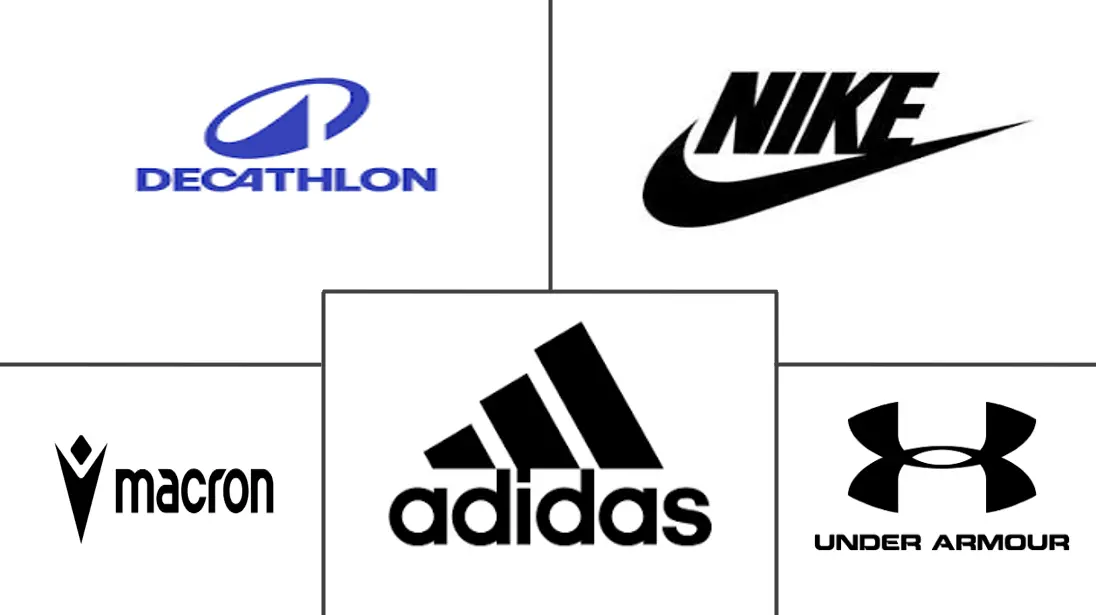Rugby Apparel Market Size and Share
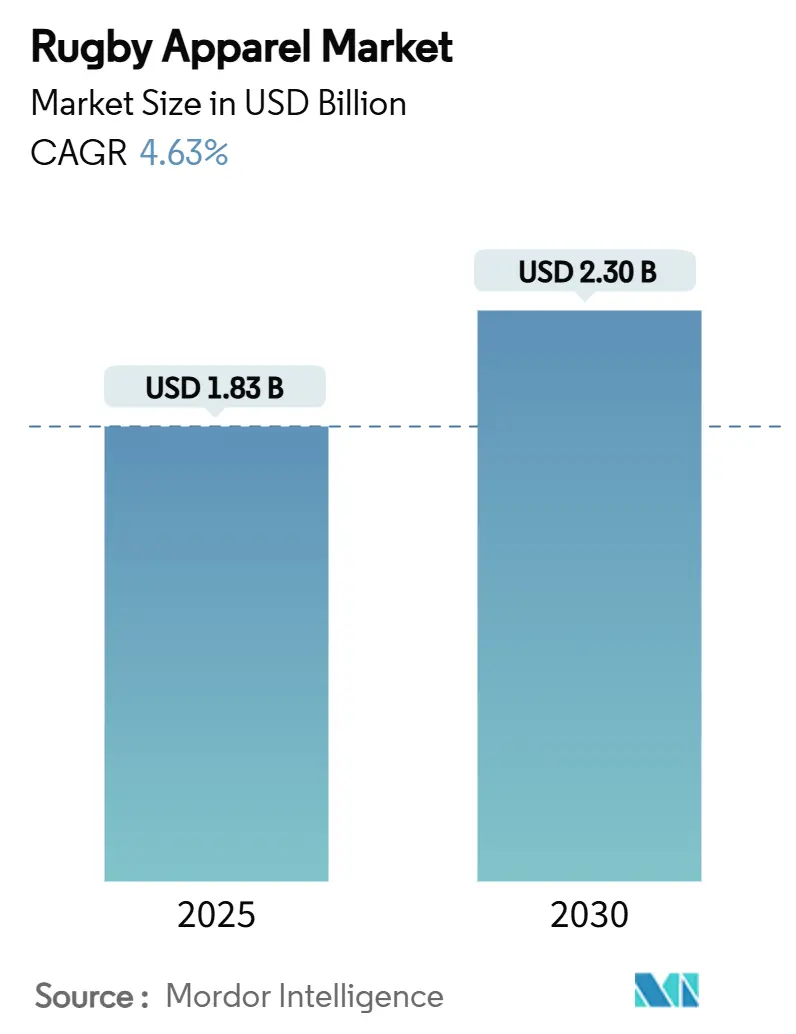
Rugby Apparel Market Analysis by Mordor Intelligence
The rugby apparel market size is projected to be valued at USD 1.83 billion in 2025 and is expected to grow to USD 2.30 billion by 2030, registering a CAGR of 4.63% during this period. This growth is driven by several factors, including increased global participation in rugby, advancements in safety gear technology, and the sport's expansion into new regions where government initiatives are encouraging the development of rugby communities. The market is segmented into various categories, with upper wear accounting for the largest share of revenue. However, protective gear is witnessing the fastest growth due to stricter safety regulations implemented by governing bodies and a rising preference among athletes for high-quality, innovative products. In terms of end-user demographics, men's rugby apparel continues to dominate the market. Professional teams remain the primary drivers of demand, contributing to two-thirds of the market's sales. The market is moderately concentrated, with a mix of global athletic brands, national federation partners, and specialized rugby apparel companies dominating the landscape. Alongside these established players, new direct-to-consumer brands are emerging, adding diversity to the competitive environment.
Key Report Takeaways
- By product type, upper wear led with 39.72% revenue share in 2024, while protective gear is projected to expand at a 5.22% CAGR through 2030.
- By end user, the men’s segment held 58.82% of the rugby apparel market share in 2024; kids/children is poised for the strongest 5.45% CAGR during 2025-2030.
- By application, professional usage accounted for a 66.61% share of the rugby apparel market size in 2024, and recreational usage is set to climb at a 5.61% CAGR to 2030.
- By distribution channel, offline stores retained 61.71% share in 2024, but online stores are advancing at a 5.82% CAGR on the strength of global merchandise platforms.
- By region, Europe commanded 43.12% revenue in 2024; Asia-Pacific is the fastest-growing geography with a 6.25% CAGR through 2030.
Global Rugby Apparel Market Trends and Insights
Drivers Impact Table
| DRIVER | (~) % IMPACT ON CAGR FORECAST | GEOGRAPHIC RELEVANCE | IMPACT TIMELINE |
|---|---|---|---|
| Technological innovations in fabric and design | +1.2% | Global, with early adoption in Europe and North America | Medium term (2-4 years) |
| Rising number of women rugby players | +0.9% | Global, strongest in established markets | Long term (≥ 4 years) |
| International events and tournament growth | +0.8% | Global, concentrated in host regions | Short term (≤ 2 years) |
| Increased media coverage and sponsorships | +0.7% | Global, emerging markets showing rapid growth | Medium term (2-4 years) |
| Increased focus on fitness and sportswear | +0.6% | Asia-Pacific, Middle East and Africa, and Latin America focus | Long term (≥ 4 years) |
| Rising awareness of player safety | +0.5% | Global, regulatory-driven in developed markets | Medium term (2-4 years) |
| Source: Mordor Intelligence | |||
Rising number of women rugby players
World Rugby and national unions highlight the significant growth in female rugby participation as a major factor driving the sport's expansion. For instance, World Rugby’s 2023/24 “Impact Beyond 2025” pilot program introduced rugby to 5,300 girls for the first time. Broader participation data shows a 38% increase in adult female registered players, compared to a 26% rise among males. In New Zealand, the NZR’s Girls Activator Programme achieved a remarkable 90% growth in women and girls participating in rugby during 2023, reaching a total of 156,833 participants. This effort contributed to 33,757 registered female players in 2024 [1]Source: New Zealand Rugby, "Girls Activator Programme contributes to record-number Women and Girls in rugby for 2024," nzrugby.co.nz. The 2024 Olympic Women’s Sevens in Paris set a new attendance record, with over 66,000 spectators watching the opening match at Stade de France, showcasing the growing fan interest in women’s rugby. These developments have encouraged sportswear brands and kit manufacturers to introduce specialized women’s rugby apparel.
International events and tournament growth
International rugby tournaments, such as the Rugby World Cup 2023 and the upcoming Women’s Rugby World Cup in 2025, play a major role in boosting the rugby apparel market. For instance, the men’s tournament held in France in 2023 generated EUR 1.8 billion in spending, highlighting its significant economic impact, according to World Rugby [2]Source: World Rugby, "The impact of Rugby World Cup 2023," world.rugby. This led to a surge in demand for products like team kits, replica jerseys, and fan merchandise. New broadcast markets, such as the United States, have seen a dramatic 136% rise in viewership since 2015, showing how televised events can quickly drive merchandise sales. Looking ahead, the Women’s Rugby World Cup in England in 2025 (scheduled for August–September) and the Men’s Rugby World Cup in 2027 are expected to continue this growth. These tournaments not only attract large global audiences but also create opportunities for brands and national unions to benefit from the excitement.
Increased media coverage and sponsorships
New media partnerships and sponsorship strategies are reshaping how rugby engages with its fans, which is having a positive impact on the rugby apparel market. For example, World Rugby’s expanded partnership with Two Circles, announced in August 2024, has significantly boosted fan interaction. In just 18 months, this collaboration helped more than double the number of direct fan connections, triple social media engagement during the Men’s Rugby World Cup, and increase users on its digital platforms by over 40%. In 2024, the French Rugby Federation reported that the majority of its operating income came from partnerships and media, contributing EUR 66.39 million. Ticket sales also played a significant role, generating EUR 30.01 million in operating income. Innovations like clickable merchandise links on platforms such as NZR+ are making it easier for fans to shop for rugby products while enjoying rugby-related content.
Rising awareness of player safety
A groundbreaking study conducted by the University of Edinburgh during the 2023–24 period analyzed over 11,000 tackles in women’s community rugby [3]Source: University of Edinburgh, "Lower tackle height changing face of women’s rugby," ed.ac.uk. The findings revealed that lowering the maximum tackle height to below the sternum significantly improved player safety. Specifically, it reduced initial head and neck contacts by 64%, decreased upright tackles by 21%, and increased the use of safer, bent-at-waist tackling techniques by 34%. These results have encouraged manufacturers to create specialized protective gear, such as padded clothing and reinforced headgear, designed to meet World Rugby’s official safety standards. These standards specify the approved protective devices and their required performance criteria. The introduction of smart mouthguards in elite competitions, starting with the 2024 Six Nations, represents a major step forward in rugby safety technology.
Restraints Impact Analysis
| RESTRAINT | (~) % IMPACT ON CAGR FORECAST | GEOGRAPHIC RELEVANCE | IMPACT TIMELINE |
|---|---|---|---|
| High cost of premium equipment | -0.8% | Global, most pronounced in emerging markets | Medium term (2-4 years) |
| Limited market reach in non-traditional rugby regions | -0.6% | Africa, Asia (excluding traditional markets), Latin America | Long term (≥ 4 years) |
| Counterfeit and duplicate products | -0.4% | Global, concentrated in online channels | Short term (≤ 2 years) |
| High risk of injuries and safety concerns | -0.3% | Global, regulatory focus in developed markets | Medium term (2-4 years) |
| Source: Mordor Intelligence | |||
High cost of premium equipment
The high cost of premium rugby gear continues to be a major challenge for market growth, especially in developing regions. For example, Adidas’s high-end Kakari RS boots, introduced in 2024, are priced at EUR 220, while the RS15 Avaglide women’s model costs EUR 160. These prices make it difficult for new and casual players to afford such equipment. Although more affordable options are available, the significant price difference limits accessibility in areas with lower income levels. Some initiatives, like Colombia’s COP 1.2 billion grassroots funding program, provide temporary support to make rugby gear more accessible. However, long-term solutions require innovations to reduce production costs, increased local manufacturing, and flexible payment options, such as installment plans. Until these measures are widely implemented, the high cost of rugby equipment will continue to slow the growth of the rugby apparel market.
Counterfeit and duplicate products
Counterfeit and fake rugby products are a growing problem that harms the market and reduces consumer confidence. For example, in South Africa, authorities seized fake Springbok jerseys worth over R200,000 near DHL Stadium in Cape Town in September 2024. A similar raid in 2023 uncovered 67 fake branded jerseys, 50 unbranded ones, and equipment used for production, leading to arrests and exposing organized illegal activities. This issue is not limited to physical locations; fake international rugby kits are also widely sold online. A study by Red Points revealed that platforms like Facebook and Instagram are responsible for 45% of intellectual property violations in sportswear, while e-commerce sites like eBay and Amazon also play a significant role. Counterfeit products not only hurt legitimate brands and sales but also raise concerns about quality, safety, and ethical practices.
Segment Analysis
By Product Type: Protective Gear Innovation Drives Performance Evolution
Upper wear retains leadership, capturing 39.72% revenue in 2024 as performance jerseys made from recycled polyester gain traction among professional and amateur squads alike. Moisture-wicking yarns, laser-cut ventilation panels, and ergonomic seams enhance comfort during impact phases, prompting frequent re-kits across clubs and schools. Bottom wear follows closely, with compression shorts and reinforced leggings gaining usage during pre-season conditioning and contact drills. Accessories ranging from smart mouthguards to GPS pods create cross-selling opportunities that broaden average basket size within the rugby apparel market.
Protective gear books the fastest 5.22% CAGR through 2030, propelled by regulatory tailwinds and televised focus on player welfare. World Rugby’s 2024 law change mandating instrumented mouthguards in elite fixtures lifts the baseline technology standard, while University of Edinburgh research showing a drop in head-to-neck contact after tackle-height changes sparks new headgear designs. Manufacturers infuse lightweight foams and sensor arrays into shoulder pads, yielding high-margin SKUs that appeal to professionals and safety-minded youth programs. The segment’s trajectory underscores how safety requirements now dictate innovation cycles across the rugby apparel market.
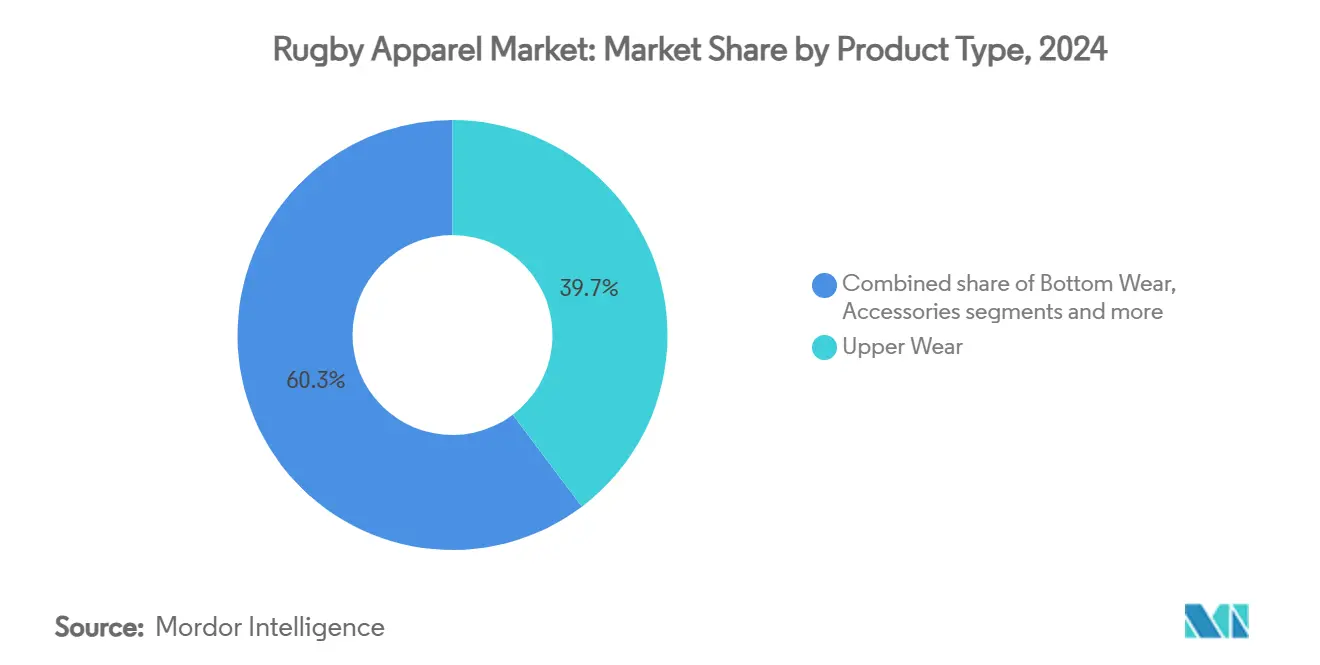
Note: Segment shares of all individual segments available upon report purchase
By End User: Youth Participation Accelerates Market Diversification
Men’s rugby apparel continues to dominate the market, holding a 58.82% share in 2024. This dominance is driven by well-established professional leagues, high-profile televised matches, and strong sponsorship deals that encourage the purchase of premium gear. Manufacturers are catering to this demand with specialized products like the Kakari RS forward boot, designed to enhance performance through advanced biomechanics and lightweight materials. The popularity of iconic men’s teams, such as the All Blacks and Springboks, fuels significant sales of replica jerseys among fans, further boosting the segment's growth. The combination of professional appeal and fan engagement ensures that men’s rugby apparel remains a key revenue driver in the market.
On the other hand, kids'/children's rugby apparel is experiencing the fastest growth, with a projected CAGR of 5.45% through 2030. This growth is largely attributed to initiatives like World Rugby’s Get Into Rugby program, which has introduced over 1.3 million children to the sport. In regions like the United States, organizations such as USA Rugby and the US Rugby Foundation have co-funded new high school rugby programs, creating consistent demand for youth-specific gear. Similarly, Saudi Arabia has integrated rugby into school physical education programs, increasing the need for age-appropriate equipment like jerseys, boots, and protective gear. These efforts not only expand the sport’s reach but also establish a strong foundation for future growth in the children’s rugby apparel segment.
By Application: Recreational Growth Signals Market Democratization
Professional teams accounted for 66.61% of the market spending in 2024, driven by strict kit regulations, sponsorship requirements, and frequent replacements to maintain a polished appearance during televised matches. Clubs invest heavily in certified protective gear and advanced technology, such as data-tracking inserts, to enhance player performance and safety. Additionally, exclusive tournament collections, like those for the Rugby World Cup 2023 and regional sevens tournaments, contribute significantly to bulk orders and fan merchandise sales. These factors ensure that professional teams remain a dominant force in the rugby apparel market, with their demand shaping industry trends and innovations.
Recreational rugby is growing rapidly, with a 5.61% CAGR, as social teams, university clubs, and community leagues attract both former players and newcomers. The sport’s inclusive messaging and accessibility have led to an increased in global participation, boosting demand for jerseys, socks, and boots. Beyond the field, rugby-inspired streetwear is gaining popularity, blending sportswear with casual fashion and expanding the market’s reach. This growth in recreational play and lifestyle adoption is helping rugby apparel move beyond traditional stadium settings and into everyday wardrobes, creating new opportunities for manufacturers and retailers.
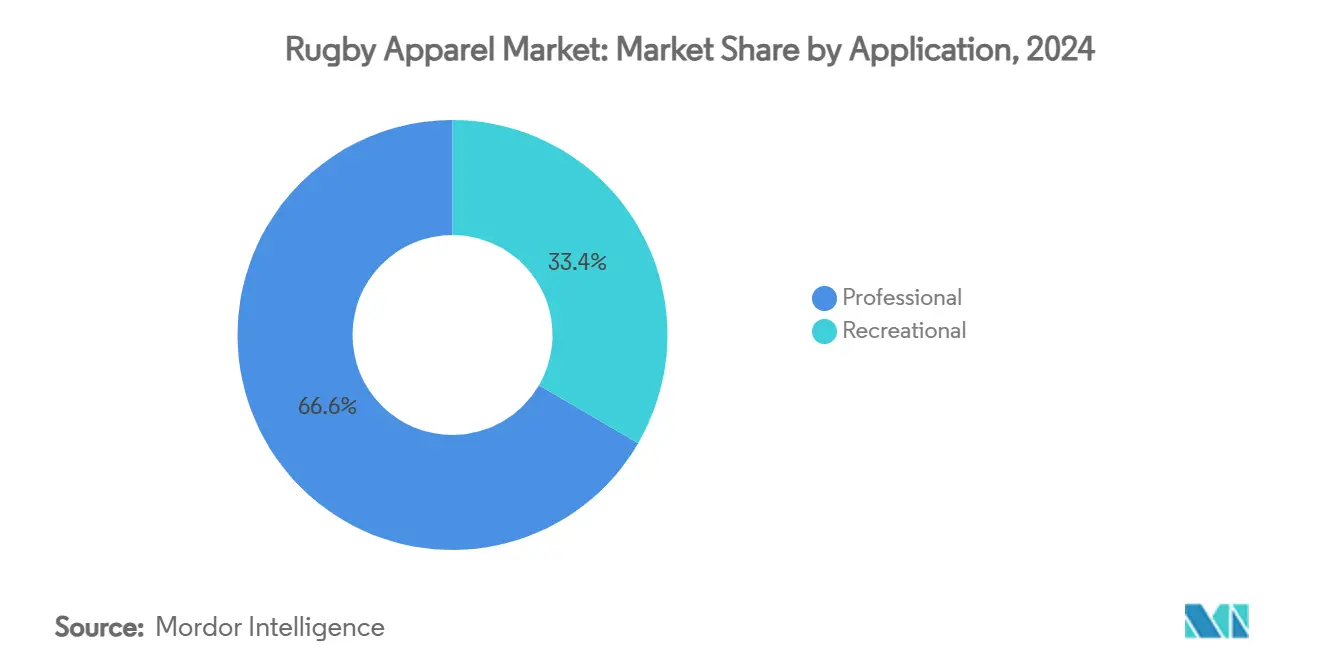
By Distribution Channel: Digital Transformation Accelerates Online Growth
Offline stores continue to dominate the rugby apparel market, accounting for 61.71% of revenue in 2024. These stores attract customers by offering personalized services, such as expert advice and proper boot-fitting, which are crucial for player safety and comfort. Fans also prefer the hands-on experience of trying out protective gear before purchasing. Stadium retail outlets remain a significant revenue driver, with partnerships like New Zealand Rugby’s collaboration with Fanatics, which operates large in-venue stores during major matches. These physical outlets provide a unique shopping experience, especially during live events, where fans can purchase exclusive merchandise and feel more connected to the sport.
Online stores, on the other hand, are growing rapidly, with a projected CAGR of 5.82%. This growth is fueled by collaborations like the World Rugby–Fanatics partnership, which ensures official merchandise is always available online with local pricing options. The rise of e-commerce aligns with the Asian Development Bank’s projection that online sales will account for 6.1% of global GDP by 2025 [4]Source: Asian Development Bank, "E-COMMERCE EVOLUTION IN ASIA AND THE PACIFIC," adb.org. Asia-Pacific, being the fastest-growing region for rugby apparel, plays a key role in this trend. Features like real-time inventory updates, fast shipping options, and mobile-friendly checkouts make online shopping more convenient for fans worldwide, especially in regions where physical stores are limited. This shift is helping the rugby apparel market expand its reach to a broader audience.
Geography Analysis
Europe leads the rugby apparel market, contributing 43.12% of the revenue in 2024. This dominance is driven by well-established professional leagues, a strong network of clubs, and major tournaments that attract global attention. The Rugby World Cup 2023, hosted by France, generated a significant economic impact of EUR 871 million and boosted sales of licensed jerseys to record levels. Countries like England, Wales, Scotland, and Ireland continue to invest in youth development programs, ensuring a steady flow of talent and consistent demand for rugby gear. The upcoming Women’s Rugby World Cup in England in 2025 is expected to further drive merchandise sales, supported by extensive media coverage and fan engagement initiatives.
The Asia-Pacific region is the fastest-growing market, with a projected CAGR of 6.25% through 2030. Government initiatives, such as Saudi Arabia’s inclusion of rugby in school curriculums and China’s investment in rugby infrastructure through partnerships with Alibaba, are fostering long-term interest in the sport. Local leagues, like Hong Kong’s 81-team competition and the South China Tigers’ professional efforts, are creating strong rugby communities that fuel demand for apparel. Additionally, the region’s advanced e-commerce platforms help brands overcome logistical challenges, allowing them to reach emerging markets efficiently and with minimal inventory risks, further boosting the market’s growth.
North America is also gaining momentum, thanks to increased visibility from rugby’s inclusion in the Olympics and the upcoming 2028 Los Angeles Games. The expansion of Major League Rugby, including the launch of Anthem Rugby Carolina in 2024, is creating local stars and generating interest in the sport. This growth is complemented by USA Rugby’s funding for high school programs, which is encouraging youth participation and driving demand for rugby apparel. The combination of professional league expansion, grassroots development, and online retail channels is helping North America strengthen its position in the global rugby apparel market.
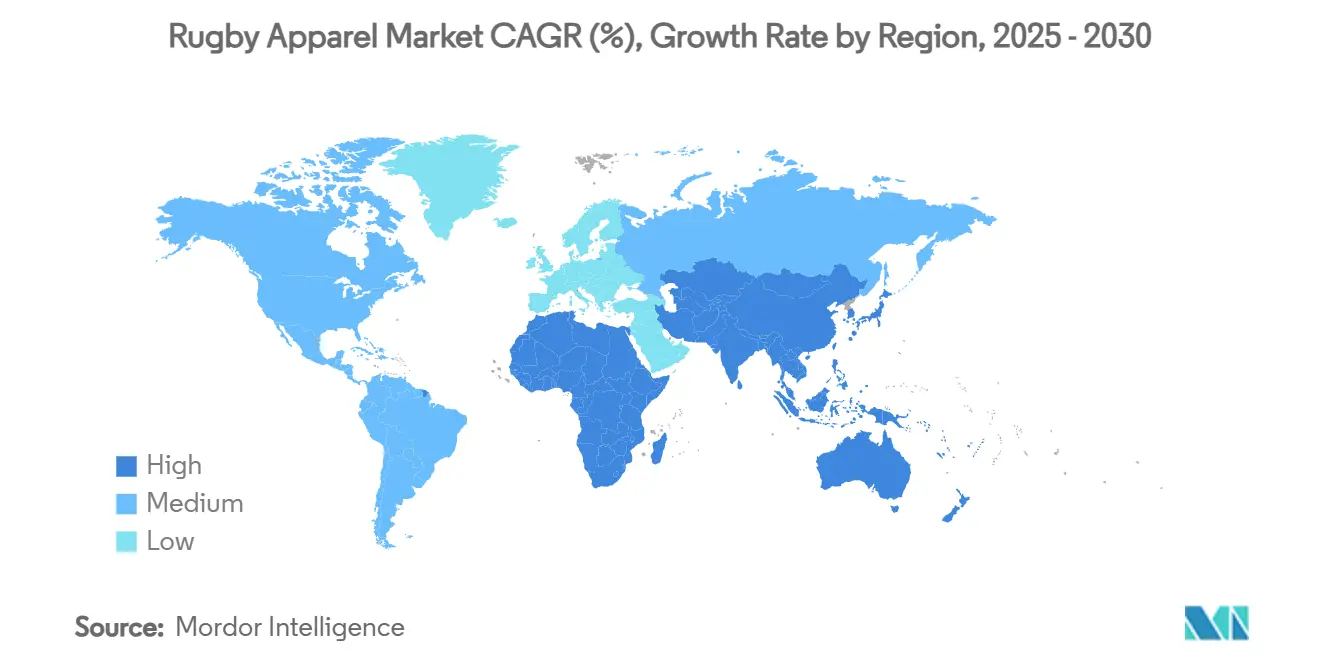
Competitive Landscape
The rugby apparel market is moderately concentrated, with global athletic giants, national federation partners, and heritage rugby brands coexisting alongside emerging direct-to-consumer companies. Adidas, for instance, has maintained a 25-year partnership with New Zealand Rugby, offering a wide range of products, including performance footwear, training apparel, and fan-focused lifestyle collections. Nike, leveraging its expertise across multiple sports, incorporates rugby-specific insights into its product development, often testing innovations with sponsored athletes. Heritage brands like Canterbury and Gilbert remain relevant by focusing on protective gear and grassroots sponsorships, which help them maintain a strong presence in schools and local communities.
Research and development in the rugby apparel market now heavily focus on advanced technologies like smart textiles and sensor-enabled gear. Companies are investing in innovations such as chip-enabled mouthguards, GPS-equipped vests, and fabrics that adapt to moisture levels. These developments are often carried out in collaboration with universities and governing bodies to ensure safety and performance standards are met. World Rugby’s certification requirements create challenges for new entrants, giving an advantage to established players who align their products with these regulations early. This focus on innovation and compliance is driving the market forward while enhancing player safety and performance.
Digital platforms are becoming increasingly important in complementing physical retail stores. Leading brands now operate their own online shops, offering match-day jersey launches and exclusive collections. Federations are also integrating e-commerce into their streaming platforms, allowing fans to shop directly while watching games. Fanatics, for example, uses a global cloud commerce system to manage real-time inventory, enabling personalized storefronts for major tournaments. These advancements in technology and retail strategies are reshaping the rugby apparel market, making it more accessible and engaging for fans worldwide.
Rugby Apparel Industry Leaders
-
Adidas AG
-
Nike, Inc
-
Decathlon SA
-
Macron S.p.A
-
Under Armour Inc.
- *Disclaimer: Major Players sorted in no particular order
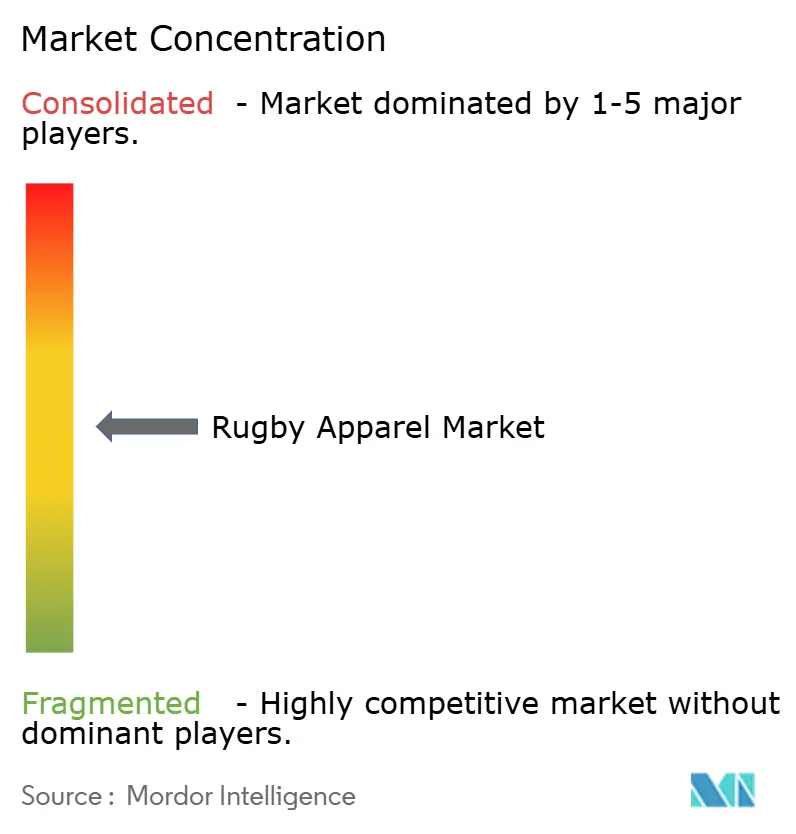
Recent Industry Developments
- July 2025: Adidas and New Zealand Rugby launched the 2025 All Blacks Jersey. Taking inspiration from classic rugby looks of the past, the new jersey incorporates subtle horizontal striped hoops engineered directly on the black canvas of one of the most famous jerseys in sport
- June 2025: Adidas launched the RS15 Avaglide, the first women-specific rugby boot, applying waterfall heel geometry and TPU support inserts to address female biomechanics.
- May 2024: Fanatics and Warner Bros in partnership with England Rugby launched a limited-edition Looney Tunes merchandise collection, as part of Warner Bros. Discovery’s newly launched Team Looney Tunes initiative.
- April 2024: Samurai, a sports apparel company launched its new innovative product, the Artemis Rugby Shirt. As per the brand's claim, the new shirt is Made from 100% recycled IKOMA fabric and combines eco-consciousness with high-performance functionality.
Global Rugby Apparel Market Report Scope
Rugby apparel encompasses clothing and accessories tailored for rugby players and enthusiasts. This market features jerseys, shorts, socks, and accessories such as caps and hats. The Rugby Apparel market is categorized by product type, end-user, distribution channel, and geography. Product types include upper wear, bottom wear, socks, and various accessories. End-users are divided into men, women, and children. Distribution channels consist of both offline and online avenues. Geographically, the market spans North America, Europe, Asia-Pacific, and the Rest of the World. The report offers the market size in value terms in USD for all the abovementioned segments
| Upper Wear |
| Bottom Wear |
| Accessories |
| Protective Gear |
| Men |
| Women |
| Kids/Children |
| Professional |
| Recreational |
| Offline Stores |
| Online Stores |
| North America | United States |
| Canada | |
| Rest of North America | |
| Europe | Germany |
| United Kingdom | |
| Italy | |
| France | |
| Spain | |
| Austria | |
| Belgium | |
| Rest of Europe | |
| Asia-Pacific | China |
| Japan | |
| Australia | |
| Indonesia | |
| South Korea | |
| Rest of Asia-Pacific | |
| South America | Brazil |
| Argentina | |
| Rest of South America | |
| Middle East and Africa | South Africa |
| Nigeria | |
| Algeria | |
| Rest of Middle East and Africa |
| By Product Type | Upper Wear | |
| Bottom Wear | ||
| Accessories | ||
| Protective Gear | ||
| By End User | Men | |
| Women | ||
| Kids/Children | ||
| By Application | Professional | |
| Recreational | ||
| By Distribution Channel | Offline Stores | |
| Online Stores | ||
| By Geography | North America | United States |
| Canada | ||
| Rest of North America | ||
| Europe | Germany | |
| United Kingdom | ||
| Italy | ||
| France | ||
| Spain | ||
| Austria | ||
| Belgium | ||
| Rest of Europe | ||
| Asia-Pacific | China | |
| Japan | ||
| Australia | ||
| Indonesia | ||
| South Korea | ||
| Rest of Asia-Pacific | ||
| South America | Brazil | |
| Argentina | ||
| Rest of South America | ||
| Middle East and Africa | South Africa | |
| Nigeria | ||
| Algeria | ||
| Rest of Middle East and Africa | ||
Key Questions Answered in the Report
What is the current value of the rugby apparel market?
The rugby apparel market is valued at USD 1.83 billion in 2025 and is forecast to reach USD 2.30 billion by 2030.
Which segment grows fastest within the rugby apparel market?
Protective gear is projected to expand at a 5.22% CAGR through 2030, buoyed by new safety mandates and sensor-enabled designs.
How significant is children’s demand for rugby apparel?
Kids/children apparel posts a 5.45% CAGR as school curricula and grassroots programs fuel youth participation and recurring kit purchases.
Why is Asia-Pacific the fastest-growing region?
Government-led sport adoption, robust e-commerce infrastructure, and major private investments push Asia-Pacific to a 6.25% CAGR through 2030.
Page last updated on:
